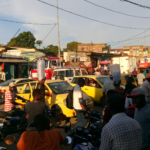Fukushima and the Doomsday Clock
By Kennette Benedict | August 11, 2011
When dreadful events occur, reporters, readers, and interested citizens contact the Bulletin of the Atomic Scientists asking whether we will move the minute hand of the Doomsday Clock. The alarming nuclear disaster at the Fukushima Daiichi Power Station on March 11 prompted e-mails and calls to our office seeking the Bulletin‘s reaction as well as accurate information about what was happening in Japan. The Bulletin responded by devoting its website to daily briefings from experts in Japan and to news from Bulletin writers on what they were hearing about this second-worst disaster in the history of the nuclear power industry. Additionally, the Bulletin will take deeper dives into the lessons and impacts of Fukushima in the September/October issue of its digital journal.
Still, the larger question remains: Should we move the hand of the Doomsday Clock? What does the Fukushima event imply for humanity’s future on the planet?
What is the Doomsday Clock? The Doomsday Clock is the indicator of threats to human survival. The editors of the Bulletin of the Atomic Scientists used it in 1947 as the cover design of the magazine to convey the dangers we faced from nuclear weapons. They moved the hand in 1949, when the Soviet Union tested its first atomic bomb, confirming the scientists’ worst fears that the creation of the bomb would lead to an arms race between the United States and the Soviet Union. Since then, the Clock hand has moved 18 times — closer and further away from the metaphoric midnight, which signifies the end of civilization from a nuclear holocaust.
Of course, nowadays other technologies can also spell doom for humanity — from the coal-fired power plants and fossil-fuel-burning engines that spew carbon dioxide into the atmosphere and cause climate change to the advances in biological and chemical weapon technologies that threaten global security. Doomsday may come, in other words, in forms so rapid — be they nuclear threats, biological agents, or climate change — that we humans may not adapt in time to prevent our own demise.
How do we determine the time? In annual Clock discussions, the Bulletin‘s Science and Security Board — the keepers of the Clock — reviews the trends and current events that reveal how well or how poorly humanity regulates the perilous forces unleashed by our own ingenuity and industry. Moving the minute hand of the Doomsday Clock is a judgment, then, an assessment of the human capacity to control technologies that can lead to irreversible catastrophe — to the end of civilization. With growing worldwide interest in nuclear energy for economic development, it’s important to know how well firms and societies are handling this dangerous technology.
Questions for a post-Fukushima world. The Bulletin‘s Board members are following the events at the Fukushima Daiichi nuclear power plant in Japan very closely. Questions about the continuing disaster range from the detailed and technical to the societal and ethical; the answers will have implications for any long-term commitment to nuclear power.
On the technical end, it appears that the underlying cause of the three core meltdowns, the hydrogen explosions, and the subsequent release of radioactive material was the loss of coolant to the nuclear cores, which was ultimately due to the loss of electrical power to the reactors. Without power to circulate the water that cooled the fuel rods, nothing could have prevented the core meltdowns. In light of this failure, questions center on reactor design and handling of nuclear fuel. Can reactors be designed without a reliance on electrical power to maintain the proper core temperature? In the event of system failure, are there better alternatives to human intervention? Stronger safety designs have been proposed in the past — ones that are more straightforward and less Rube Goldberg-like than the complicated systems currently used. Why haven’t they been developed? Meanwhile, the handling of nuclear fuel continues to defy logic: Why is spent fuel still stored at power plants — raising the odds of damage and the subsequent release of radioactive materials in accidents? What exactly are the obstacles to placing spent fuel in long-term storage repositories?
A second set of questions focuses on operations, regulation, and public knowledge about nuclear reactors. How can regulatory agencies maintain independence from the nuclear industry and enforce rigorous safety standards? What prevents the industry from being more transparent about operations, especially when leaks and mishaps occur? If existing regulatory arrangements appear inadequate, then could a different structure of economic incentives encourage utilities to make their nuclear power plants safer and more secure? In the United States, for example, current law limits industry liability in the event of an accident. Does the limit on legal liability in the event of an accident reduce firms’ incentives not only to develop the safest designs possible but also to ensure the most rigorous oversight of maintenance and operations?
More broadly, how can societies and communities meet their energy needs with the least risk and the greatest payoff for economic development? Are there alternatives based on precautionary principles — first do no harm — that involve less peril to safety, health, and community than nuclear or fossil-fueled power? Are we locked into the current energy development path? How should we think about the trade-offs between injury and disruption from energy technologies and future injury and disruption from climate change?
But have we learned anything? These questions are difficult to answer and the trade-offs nearly impossible to calculate. Even harder, however, will be implementing policy recommendations in a world of vested interests tied to old technologies. Over the past 100 years or so, the world’s “energy portfolio” did not diversify very much — as electric and gas-fueled engines powered industrial development. Renewable energy technologies like wind, solar, and biofuels hold great potential, but require much more rapid development to substitute for fossil fuels and nuclear power in the near term. So it appears now that there are few good choices: Either warm the planet’s atmosphere and oceans, with dire consequences for human societies as the climate rapidly changes, or place communities in jeopardy from nuclear plant accidents and releases of deadly radioactive materials.
However, in January 2012, when the Bulletin deliberates about moving the hand of the Doomsday Clock, the most important question will be: What have governments, firms, and citizens learned from the Fukushima disaster about managing Earth-altering technologies? And will they act on what they have learned in time to avert future disaster?
Together, we make the world safer.
The Bulletin elevates expert voices above the noise. But as an independent nonprofit organization, our operations depend on the support of readers like you. Help us continue to deliver quality journalism that holds leaders accountable. Your support of our work at any level is important. In return, we promise our coverage will be understandable, influential, vigilant, solution-oriented, and fair-minded. Together we can make a difference.
Topics: Biosecurity, Climate Change, Columnists, Nuclear Energy, Nuclear Weapons















